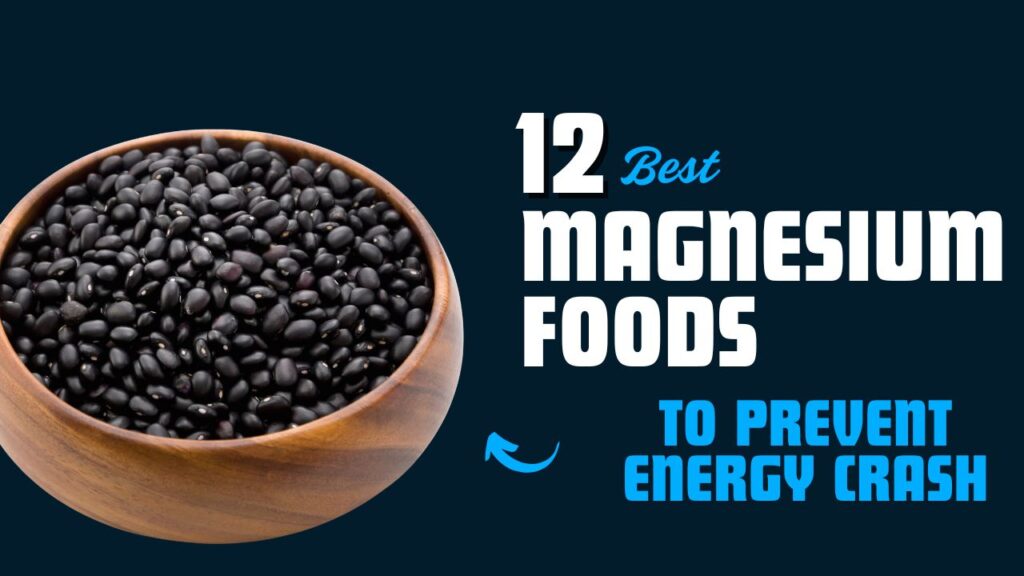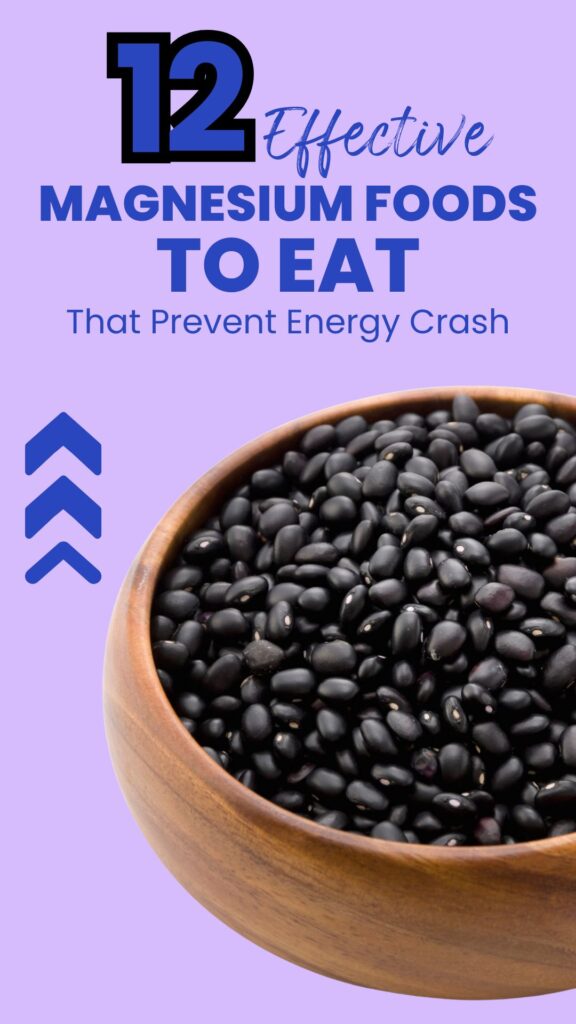Do you often feel drained halfway through your day, even after a full night’s sleep? One of the most overlooked reasons for constant fatigue is magnesium deficiency.
Magnesium is not just another mineral—it plays a crucial role in over 300 biochemical reactions in your body, including energy production, muscle recovery, and nerve function. Surprisingly, studies suggest that nearly 50% of people in modern diets aren’t getting enough magnesium.
Without enough of this mineral, your body struggles to regulate blood sugar, process energy efficiently, and even manage stress hormones—all leading to that dreaded afternoon crash.
In this post, you’ll discover 12 powerful magnesium-rich foods that can help you prevent energy dips, improve focus, and support long-term health. For each food, you’ll learn:
- Best ways to eat or use it.
- Who should eat it and who may need to avoid it.
- Smart storage and buying tips.
- Do’s and don’ts for maximum benefits.
- Possible side effects if consumed in excess.
Let’s dive into the foods that can keep your energy steady and your body strong.

Table of Contents

12 Best Magnesium Rich Foods To Eat
1. Spinach
Best Ways to Eat or Use It
- Add fresh spinach to smoothies for a nutrient-packed start.
- Lightly sauté with garlic and olive oil as a side dish.
- Use raw in salads to preserve magnesium content.
Who Should Eat / Avoid
- Good for: athletes, people with anemia, those looking to improve digestion.
- Avoid if: you have kidney stones, as spinach is high in oxalates.
Storage & Buying Tips
- Choose fresh, dark green leaves without yellow spots.
- Store in a breathable bag in the refrigerator and consume within 3–5 days.
Do’s & Don’ts
✅ Do: lightly steam to retain nutrients.
❌ Don’t: boil for too long—it leaches magnesium.
Possible Side Effects
- Overeating raw spinach may cause bloating or kidney stone risks in sensitive individuals.
2. Pumpkin Seeds
Best Ways to Eat or Use It
- Snack on roasted pumpkin seeds.
- Sprinkle on oatmeal, salads, or yogurt.
- Blend into smoothies for an energy boost.
Who Should Eat / Avoid
- Good for: busy professionals, students, athletes (great for recovery).
- Avoid if: you have seed allergies.
Storage & Buying Tips
- Buy raw, unsalted seeds for best nutritional value.
- Store in an airtight container to prevent them from going rancid.
Do’s & Don’ts
✅ Do: eat a handful daily.
❌ Don’t: rely on salted or heavily flavored versions—they often contain excess sodium.
Possible Side Effects
- Eating too many may cause mild digestive upset due to high fiber.
3. Almonds
Best Ways to Eat or Use It
- Snack on raw almonds.
- Use almond butter as a spread or smoothie base.
- Add to trail mix with dried fruits.
Who Should Eat / Avoid
- Good for: those looking for healthy fats, brain function, and steady energy.
- Avoid if: you have nut allergies.
Storage & Buying Tips
- Choose raw or dry-roasted almonds.
- Store in a cool, dry place or refrigerate to extend shelf life.
Do’s & Don’ts
✅ Do: soak overnight to improve digestion.
❌ Don’t: overconsume—too many can add extra calories quickly.
Possible Side Effects
- Excess almonds may cause weight gain due to calorie density.
4. Dark Chocolate (70% or Higher)
Best Ways to Eat or Use It
- Enjoy a small square after meals.
- Add shaved chocolate to oatmeal or smoothie bowls.
- Use in baking with minimal sugar.
Who Should Eat / Avoid
- Good for: those needing a mood lift and energy boost.
- Avoid if: sensitive to caffeine or managing sugar intake.
Storage & Buying Tips
- Pick bars with 70% cocoa or higher.
- Store in a cool, dark place away from heat.
Do’s & Don’ts
✅ Do: enjoy in moderation for a healthy magnesium dose.
❌ Don’t: confuse milk chocolate with dark—it has far less magnesium.
Possible Side Effects
- Too much may lead to caffeine-related jitters.
5. Avocados
Best Ways to Eat or Use It
- Mash on whole-grain toast.
- Add to salads or smoothies.
- Blend into creamy dips.
Who Should Eat / Avoid
- Good for: heart health, pregnant women (rich in folate), athletes.
- Avoid if: you’re on a strict low-fat diet or allergic.
Storage & Buying Tips
- Buy slightly firm avocados that yield to gentle pressure.
- Store ripe ones in the fridge to slow ripening.
Do’s & Don’ts
✅ Do: pair with tomatoes for enhanced nutrient absorption.
❌ Don’t: leave cut avocados exposed—oxidation reduces freshness.
Possible Side Effects
- Overeating may cause weight gain due to high fat content.
6. Black Beans
Best Ways to Eat or Use It
- Add to burritos, tacos, or chili.
- Blend into soups or dips.
- Pair with rice for a complete protein source.
Who Should Eat / Avoid
- Good for: vegetarians, diabetics (low glycemic index), and weight watchers.
- Avoid if: you have digestive issues with legumes.
Storage & Buying Tips
- Choose dried beans and soak overnight for best results.
- Canned beans are convenient but rinse to remove excess sodium.
Do’s & Don’ts
✅ Do: combine with vitamin C foods for better absorption.
❌ Don’t: eat undercooked beans—they contain lectins that may cause stomach upset.
Possible Side Effects
- May cause gas or bloating if not soaked or cooked properly.
7. Cashews
Best Ways to Eat or Use It
- Snack on raw cashews.
- Use in stir-fries or curries.
- Blend into creamy sauces.
Who Should Eat / Avoid
- Good for: boosting immunity, brain function, and energy.
- Avoid if: nut allergies or kidney problems.
Storage & Buying Tips
- Buy unsalted cashews.
- Store in airtight containers away from heat.
Do’s & Don’ts
✅ Do: include as a protein-rich snack.
❌ Don’t: deep fry—destroys nutrients.
Possible Side Effects
- High in calories, so moderation is key.
8. Bananas
Best Ways to Eat or Use It
- Eat fresh as a quick snack.
- Add to smoothies, oatmeal, or pancakes.
- Freeze and blend into healthy ice cream.
Who Should Eat / Avoid
- Good for: athletes, kids, people with high activity levels.
- Avoid if: managing blood sugar spikes.
Storage & Buying Tips
- Buy bananas slightly green and let ripen at room temperature.
- Store ripe bananas in the fridge to slow spoilage.
Do’s & Don’ts
✅ Do: pair with nut butter for balanced energy.
❌ Don’t: eat overly ripe bananas if sensitive to sugar.
Possible Side Effects
- Excess consumption may increase blood sugar in diabetics.
9. Swiss Chard
Best Ways to Eat or Use It
- Sauté with olive oil and garlic.
- Add to soups and stews.
- Use raw in green juices.
Who Should Eat / Avoid
- Good for: people needing iron and magnesium combo.
- Avoid if: prone to kidney stones (oxalates present).
Storage & Buying Tips
- Look for crisp, brightly colored leaves.
- Store in the fridge wrapped in a damp towel.
Do’s & Don’ts
✅ Do: lightly steam to reduce oxalates.
❌ Don’t: overcook—it reduces mineral content.
Possible Side Effects
- Overconsumption may cause digestive upset.
10. Quinoa
Best Ways to Eat or Use It
- Use as a rice substitute.
- Add to salads, soups, or breakfast bowls.
- Cook with vegetable broth for more flavor.
Who Should Eat / Avoid
- Good for: vegetarians (complete protein), gluten-free diets.
- Avoid if: you have seed sensitivities.
Storage & Buying Tips
- Buy pre-rinsed quinoa to reduce bitterness.
- Store in a cool, dry place.
Do’s & Don’ts
✅ Do: rinse thoroughly before cooking.
❌ Don’t: undercook—it will taste bitter.
Possible Side Effects
- May cause bloating in sensitive individuals.
11. Yogurt
Best Ways to Eat or Use It
- Enjoy with fruits and nuts.
- Use in smoothies or parfaits.
- Replace cream in sauces or dips.
Who Should Eat / Avoid
- Good for: gut health, athletes, and bone strength.
- Avoid if: lactose intolerant or allergic to dairy.
Storage & Buying Tips
- Choose plain, unsweetened yogurt with live cultures.
- Store in the fridge and consume within a week of opening.
Do’s & Don’ts
✅ Do: pair with magnesium-rich seeds for added benefit.
❌ Don’t: rely on sugary flavored yogurts.
Possible Side Effects
- Too much dairy may cause digestive discomfort in sensitive people.
12. Tofu
Best Ways to Eat or Use It
- Stir-fry with vegetables.
- Grill or bake with marinades.
- Blend into smoothies for extra protein.
Who Should Eat / Avoid
- Good for: vegetarians, post-menopausal women (supports bone health).
- Avoid if: soy allergies or thyroid issues (in excess).
Storage & Buying Tips
- Buy firm or extra-firm tofu for cooking.
- Store in water and change daily if not used immediately.
Do’s & Don’ts
✅ Do: marinate before cooking for better flavor.
❌ Don’t: leave at room temperature—it spoils quickly.
Possible Side Effects
- Excess soy intake may interfere with thyroid function in sensitive individuals.
Conclusion
Magnesium is often called the “energy mineral”, and for good reason. Without enough of it, your body simply cannot produce, store, or use energy efficiently.
By including foods like spinach, pumpkin seeds, almonds, avocado, and tofu in your daily meals, you’re not only fueling your body but also supporting long-term health—everything from heart function to mental clarity.
These 12 magnesium foods are easy to incorporate into your everyday diet. Start by adding one or two this week—whether it’s a spinach smoothie, a handful of pumpkin seeds, or an avocado toast—and notice how much steadier your energy feels.
What’s your favorite magnesium-rich recipe? Share it in the comments and inspire others to keep their energy levels strong all day long.
Frequently Asked Questions (FAQs)
Why is magnesium important for energy?
Magnesium helps convert food into energy at the cellular level. Without enough magnesium, your body struggles to produce ATP—the main energy molecule—leading to fatigue.
How do I know if I’m low on magnesium?
Common symptoms include muscle cramps, low energy, poor sleep, irritability, and frequent headaches. However, a blood test is the most reliable way to check.
How much magnesium do I need daily?
The recommended daily allowance (RDA) is about 310–420 mg for adults, depending on age and gender.
Can I get enough magnesium from food alone?
Yes, if you regularly consume foods like leafy greens, nuts, seeds, legumes, and whole grains. In some cases, supplements may be needed under medical advice.
Do magnesium-rich foods help with sleep?
Yes. Magnesium regulates melatonin production and relaxes the nervous system, improving sleep quality.
Can I eat too much magnesium?
It’s rare from food sources, but excessive magnesium from supplements can cause diarrhea, nausea, and in severe cases, heart issues.
Are bananas really good for magnesium?
Yes, bananas contain magnesium along with potassium, making them excellent for preventing energy crashes and supporting muscle health.
Which magnesium-rich foods are best for vegetarians?
Quinoa, spinach, black beans, tofu, pumpkin seeds, and almonds are all vegetarian-friendly magnesium powerhouses.
Do cooking methods affect magnesium levels in food?
Yes. Boiling vegetables can reduce magnesium levels. Steaming, sautéing, or eating raw is better for nutrient retention.
Can magnesium foods help athletes?
Absolutely. Magnesium supports muscle recovery, reduces cramps, and maintains steady energy levels—making it vital for athletes.










